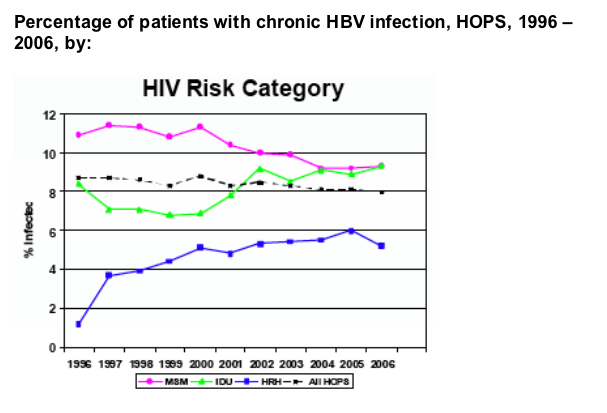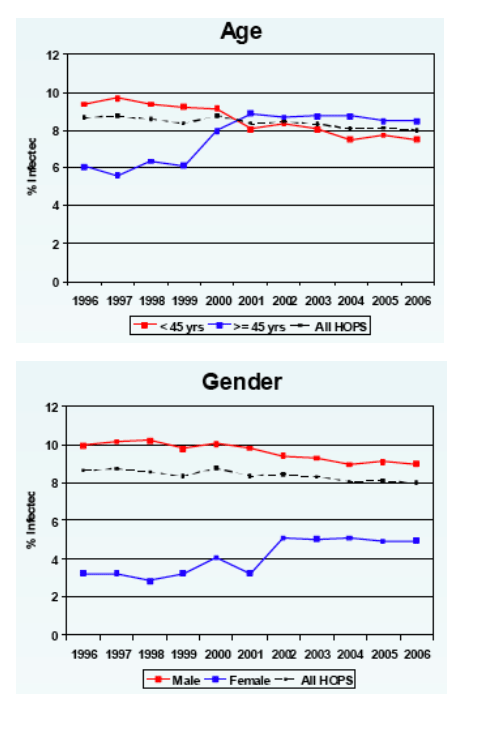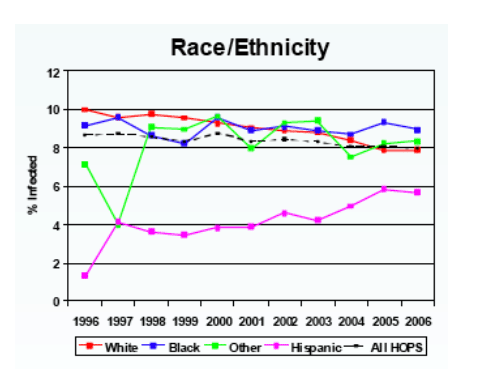 |
 |
 |
| |
Chronic Hepatitis B Virus (HBV) Infection in the HIV Outpatient Study (HOPS), 1996-2006: Prevalence in the Era of Evolving Interventions
|
| |
| |
Reported by Jules Levin
ICAAC/IDSA Oct 2008 Wash DC
Philip R. Spradling1, J. T. Richardson2, K. Buchacz1, A. Moorman1, J. T. Brooks1and the HIV Outpatient Study (HOPS) Investigators; 1Centers for Disease Control and Prevention, Atlanta, GA, 2Cerner Corporation, Vienna, VA.
AUTHOR CONCLUSIONS
The prevalence of chronic HBV infection in the HOPS was unchanged over the past decade among all patients in all demographic and HIV risk groups
The overall prevalence of chronic HBV infection from 1996-2006 (8.6%) was over 20 times greater than national prevalence estimates (0.42%)1
This overall estimate is consistent with recent estimates from another large multi-site cohort (8.7%)2
Despite advances in the treatment of HBV/HIV coinfection, vaccination remains the most essential intervention to prevent HBV disease in HIV-infected persons
In a prior analysis of the HOPS, 32% of eligible patients received at least one dose of HBV vaccine3
ABSTRACT
Background: Co-infection with HBV is an important cause of chronic liver disease among patients infected with HIV.
Methods:We calculated the prevalence of chronic HBV infection annually from 1996-2007 by age, gender, risk factor for HIV, and race/ethnicity in the HOPS, a multi-site observational cohort study of HIV-infected patients. Prevalence was defined as the number of patients with a positive HBsAg or HBeAg or detectable HBV DNA divided by the number of patients tested for chronic HBV infection.
Results: Of the 7,050 patients in the HOPS during 1996 to 2006, 4,315 (61.2%) were tested for chronic HBV infection. Of these, 369 (8.6%) were positive for HBsAg or HBeAg or detectable HBV DNA. Annual chronic HBV prevalence ranged from 8.0% to 8.7% over the study period with slight downward trend (not statistically significant). Prevalence was highest among patients aged 40-49
years, men, and men who have sex with men.
Conclusion: The prevalence of chronic HBV infection in the HOPS was unchanged over the past decade among patients in all demographic and HIV risk groups, but overall was 20 times greater than national prevalence estimates (0.42%). Although HBV infection treatment options now exist for co-infected patients, vaccination of persons at risk for HBV infection remains the most essential intervention.
BACKGROUND
Coinfection with HBV is an important cause of chronic liver disease among patients infected with HIV
Recent studies suggest a decline in prevalence of HCV infection among persons infected with HIV, as well as among the general population; however, less is known about trends in the prevalence of persons coinfected with HBV and HIV
OBJECTIVES
To determine the prevalence of chronic HBV infection from 1996 to 2005 -- for each year and for the period -- in a multi-site heterogeneous cohort of HIV-infected persons with sustained outpatient follow-up
METHODS
Study Population: HIV Outpatient Study (HOPS)
A prospective cohort study of HIV-infected patients seen at 10 clinics (public and private) in 8 cities specializing in treatment of HIV disease
HOPS has collected sociodemographic and clinical data abstracted from medical charts on about 8,200 patients from 1993 to the present
Inclusion criteria
All persons enrolled in HOPS for any period of time between Jan 1, 1996 and Dec 31, 2006
A patient was considered active if the patient had > 1 HOPS-related clinic visit during a calendar year or any other interval of interest
Patients with positive HBsAg or HBeAg or detectable HBV DNA were classified as having chronic HBV infection
Patients with any test result for HBsAg or HBeAg or HBV DNA were classified as tested for chronic HBV infection
Prevalence = Number of patients with chronic HBV infection
Number of patients tested for HBV infection
RESULTS
Of the 7,050 active patients in the HOPS from 1996 through 2006, 4,315 (61.2%) were tested for HBV infection
369 of 4,315 (8.6%) were positive for HBsAg or HBeAg or HBV DNA
Annual chronic HBV infection prevalence ranged from 8.0% to 8.7% over the study period with a slightly downward trend (not statistically significant)
Prevalence was highest among patients aged 40-49 yrs, men, and men who have sex with men



Limitations
Variability among clinicians in the practice of hepatitis laboratory testing could have affected prevalence estimates
Some cases of acute HBV infection may have been included in the chronic infection prevalence estimates, because a positive test for IgM anti-HBc did not exclude a patient as long as other criteria were met
Factors involving HBV vaccination and HIV and HBV treatment were not taken into account, but could have affected HBV serologic patterns and HBV DNA levels
REFERENCES
1. McQuillan GM, Coleman PJ, Kruszon-Moran D, Moyer LA, Lambert SB, Margolis HS. Prevalence of hepatitis B virus infection in the United States: The National Health and Nutrition Examination Surveys, 1976 through 1994. Am J Public Health 1999;89:14-18.
2. Konopnicki D, Mocroft A, de Wit S, Antunes F, Ledergerber B, Katlama C, Zilmer K, Vella S, Kirk O, Lundgren JD for the EuroSIDA Group. Hepatitis B and HIV: prevalence, AIDS progression, response to highly active antiretroviral therapy and increased mortality in the EuroSIDA cohort. AIDS 2005;19:593-
601.
3. Tedaldi EM, Baker RK, Moorman AC, Wood KC, Fuhrer J, McCabe RE, Holmberg SD; HIV Outpatient Study (HOPS) Investigators. Hepatitis A and B vaccination practices for ambulatory patients infected with HIV. Clin Infect Dis. 2004;38:1478-84.
|
| |
|
 |
 |
|
|